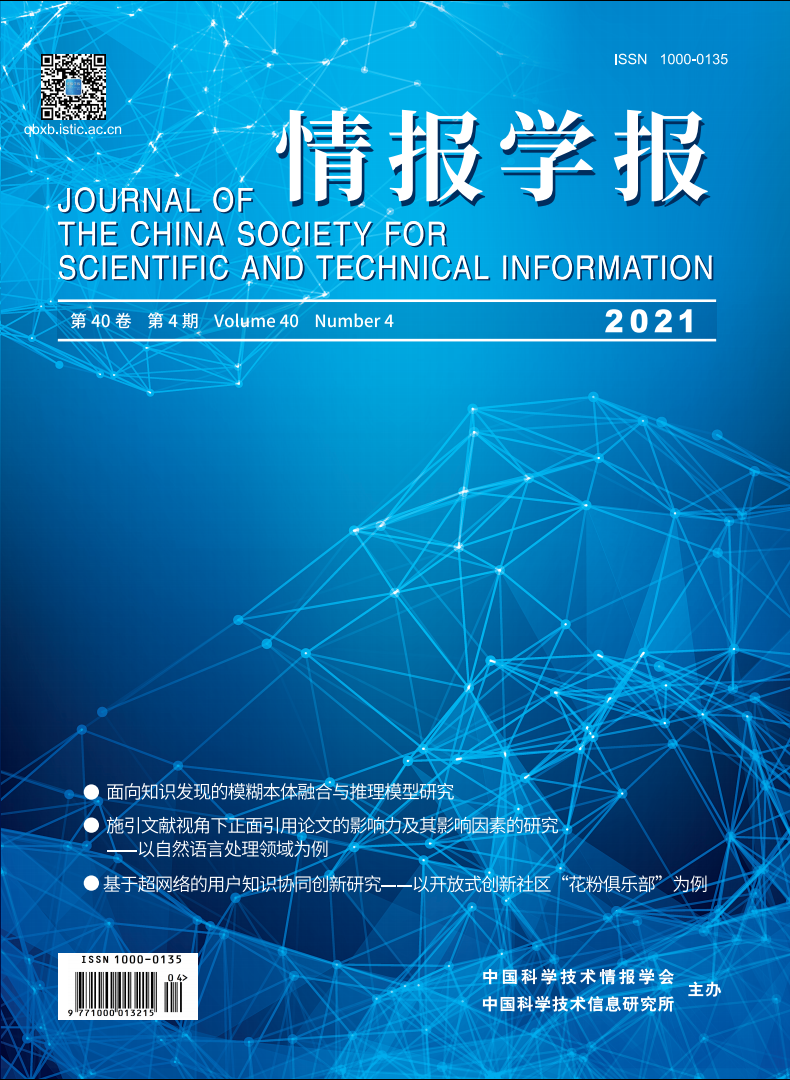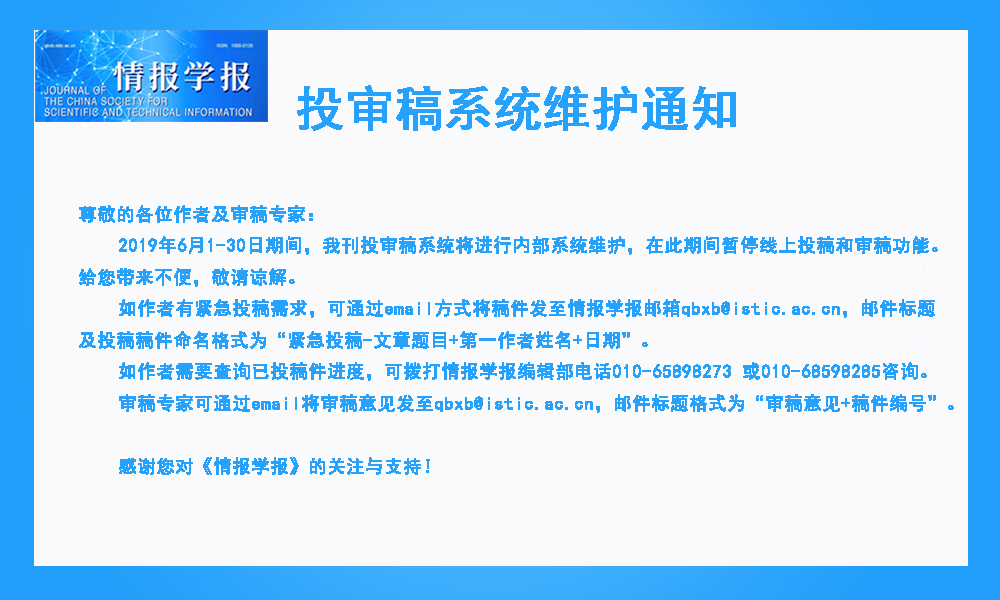 |
|
2021 Vol. 40, No. 4
Published: 2021-04-24 |
|
|
| |
|
|
|
|
|
333 |
Study on Knowledge Discovery Model Based on Fuzzy Ontology Fusion and Reasoning Hot! |
|
 |
Lu Quan, Liu Ting, Zhang Liangtao, Chen Jing |
|
|
DOI: 10.3772/j.issn.1000-0135.2021.04.001 |
|
|
Existing research on knowledge discovery struggles to balance the accuracy and ambiguity of knowledge in different fields, and lacks the language and tools to describe and define fuzzy ontology. This study proposed a fuzzy ontology representation model based on OWL (ontology web language) language from the perspective of knowledge ambiguity, and expressed precise rules and fuzzy rules using SWRL language. Combining the concept pair and membership degree, the fuzzy knowledge was transformed into precise knowledge to realize ontology fusion reasoning, and a fuzzy ontology fusion and reasoning model oriented to knowledge discovery was constructed. The drug data related to tumor or mental disease in Drugs and DrugBank databases were selected to verify the model. The results showed that the recall rate, which is particularly important for drug interaction knowledge discovery, can be significantly increased to 89.94% while maintaining the accuracy level. The fuzzy ontology model proposed in this study can describe both accurate knowledge and fuzzy knowledge, simplifying the representation and processing of fuzzy knowledge. |
|
|
2021 Vol. 40 (4): 333-344
[Abstract]
(
366
)
HTML
(158 KB)
PDF
(2104 KB)
(
1728
) |
|
|
|
345 |
Promoting the Evaluation of Representative Works: Challenges and Recommendations Hot! |
|
 |
Yu Liping, Zhang Kuangwei, Jiang Changbing |
|
|
DOI: 10.3772/j.issn.1000-0135.2021.04.002 |
|
|
The representative system has recently been implemented in scientific and technological evaluations. Analyzing and thinking about the representative system is helpful to perfect the representative system and improve the quality of scientific and technological evaluations. To this end, the present article first analyzes the evaluation object. Next, the challenges in evaluating the representative work are examined from the perspective of the evaluation purpose, evaluation object, peer review, and evaluation technology. Finally, the reliability and pass rate of the representative work is mathematically proven. Studies have found that representative evaluation suffers from the following challenges: macroscopic perspective, the interdisciplinary comparison, the author's requirement to choose between different types of work and the masterpiece, subject heterogeneity impact assessment, applicability to different academic evaluation problem, the imperfection of the peer review system, mismatch between the assessments of evaluation experts and the objective, difficulty in comparing different groups, high cost, and low reliability of assessment. Furthermore, the following policy recommendations are made. First, it is inappropriate to expand the scope of the representative work review. Second, the requirements for representative work selection should be clarified, the classification evaluation should be refined, and traditional methods should be used for junior and intermediate scholars. Finally, a review system should be established that considers both quantitative assessment and representative works, improves the quality of peer review, provides autonomy to universities in science and technology review systems, promotes bibliometric indicators, and improves the technology evaluation mechanism. |
|
|
2021 Vol. 40 (4): 345-353
[Abstract]
(
335
)
HTML
(96 KB)
PDF
(1356 KB)
(
717
) |
|
|
|
354 |
Research on the Influencing Factors and the Influence of Positive Citation Papers from the Perspective of Citing Papers: Using Natural Language Processing as an Example Hot! |
|
 |
Xu Linhong, Ding Kun, Sun Xiaoling, Yang Yang |
|
|
DOI: 10.3772/j.issn.1000-0135.2021.04.003 |
|
|
Citation frequency is an important evaluation index for scientific papers, but because of the issue of citation homogeneity, the deviation of citation frequency must be corrected. Based on data regarding citation polarity of natural language processing papers, this paper studies the influence of the differences between positive and neutral citations as well as between differently motivated positive citations. Furthermore, it discusses which factors influence an author's citation polarity. Using a nonparametric test, logistic regression, and other statistical inference methods, the study reveals that the influence of positive citations is significantly higher than that of neutral citations, and among the different reasons for positive citations, the influence of “applied” papers is greater. Furthermore, the position of the citation and the length of the citation sentence have a great influence on the citation polarity, but the citation intensity and the number of references have no influence on this polarity. This study's findings provide useful reform suggestions for further enriching citation analysis theory and refining evaluation strategies for technology quality. |
|
|
2021 Vol. 40 (4): 354-363
[Abstract]
(
231
)
HTML
(99 KB)
PDF
(1844 KB)
(
1235
) |
|
|
|
364 |
A Comparative Study of Inventor Bibliographic-Patent- Coupling and Inventor-Patent-Classification-Coupling —Non-Practicing Entities as an Example Hot! |
|
 |
Song Yanhui, Qiu Junping |
|
|
DOI: 10.3772/j.issn.1000-0135.2021.04.004 |
|
|
Patent literature, like other scientific papers, is an important scientific literature, and is significant in extensions of the method of bibliometrics to the measurement of patent literature. In this paper, non-practicing entities (NPE) patents are used as samples. Using frequency analysis, correlation analysis, factor analysis, visual analysis, and other methods, it compares the two analysis methods of Inventor Bibliographic-Patent-Coupling (IBPC) and Inventor Patent Classification-Coupling (IPCC) to explore the NPE patent structure. The results show that IBPC is correlated with IPCC. Furthermore, the results of factor analysis show that the coupling analysis of inventor's patent literature is better than that of inventor's classification. IBPC analysis can identify additional research topics. The core research fields of NPE patent discovered by IBPC and IPCC are digital computer, communication digital information transmission, and data storage and transmission, all of which can represent the structure of NPE patents. Therefore, the combination of the two will be more effective in probing and analyzing the subject structure, allowing even more valuable conclusions to be drawn. |
|
|
2021 Vol. 40 (4): 364-374
[Abstract]
(
330
)
HTML
(109 KB)
PDF
(3064 KB)
(
717
) |
|
|
|
387 |
The Inclination of Vertical Policy Diffusion in China Based on Thematic Analysis Hot! |
|
 |
Wang Fang, Xu Lulu |
|
|
DOI: 10.3772/j.issn.1000-0135.2021.04.006 |
|
|
Policy innovation is implemented and diffused via document circulation. In the era of big data, it is of great significance to employ document mining to analyze the process of policy diffusion among different levels of government. This will allow a better understanding of policy effects, promote construction of digital government systems, and improve government capabilities. However, at present, little research focus is placed on intelligent processing of government documents and policy diffusion among governments at different levels. In light of this, by this study examines themes in policy diffusion and the inclination of different government levels for policy diffusion by analyzing the structure and content of documents texts, with focus on the time of policy release, the number of policy layouts, the intensity of policy themes, the number of implementing departments, and other characteristics. Based on this analysis, the study proposes an index model to detect policy diffusion inclinations based on multi-feature fusion. Taking the policy of big data as an example, the study designs a visualization map for policy diffusion to express the thematic changes that occur during diffusion of policy from the central government to provincial and municipal levels. Through intelligent processing and theme detection in large-scale government document data, this study provides policy makers and implementers with information support and references for decision-making. |
|
|
2021 Vol. 40 (4): 387-401
[Abstract]
(
440
)
HTML
(166 KB)
PDF
(7209 KB)
(
530
) |
|
|
|
424 |
Configurational Perspective and Qualitative Comparative Analysis: The New Way of Empirical Research in Library and Information Science Hot! |
|
 |
Chi Maomao, Du Yunzhou, Wang Weijun |
|
|
DOI: 10.3772/j.issn.1000-0135.2021.04.009 |
|
|
This paper reviewed the mainstream empirical research methods used in the field of library and information science (LIS), including qualitative and quantitative research methods. As the traditional empirical research method (particularly the quantitative research method) is based on reductionism, it is challenging to analyze the complex mechanism of the independent variables' interactions and the influences of these interactions on the outcome variables. In this paper, both configurational perspective and qualitative comparative analysis (QCA) are introduced to the field of LIS. The configurational perspective is holistic and systemic, and it analyzes the determinants of outcome from the perspective of “causal recipes.” This perspective can explore causal complexity induced by multi-dimensional and multi-variable causal combinations. Therefore, this paper introduces the configurational perspective as well as the basic principle, analysis process, and specific application of QCA in the context of LIS. Finally, five research opportunities pertaining to the configurational perspective and QCA-based LIS are prospected. Thus, QCA is the new approach to conducting empirical research in LIS. |
|
|
2021 Vol. 40 (4): 424-434
[Abstract]
(
436
)
HTML
(135 KB)
PDF
(1484 KB)
(
2488
) |
|
|
|


